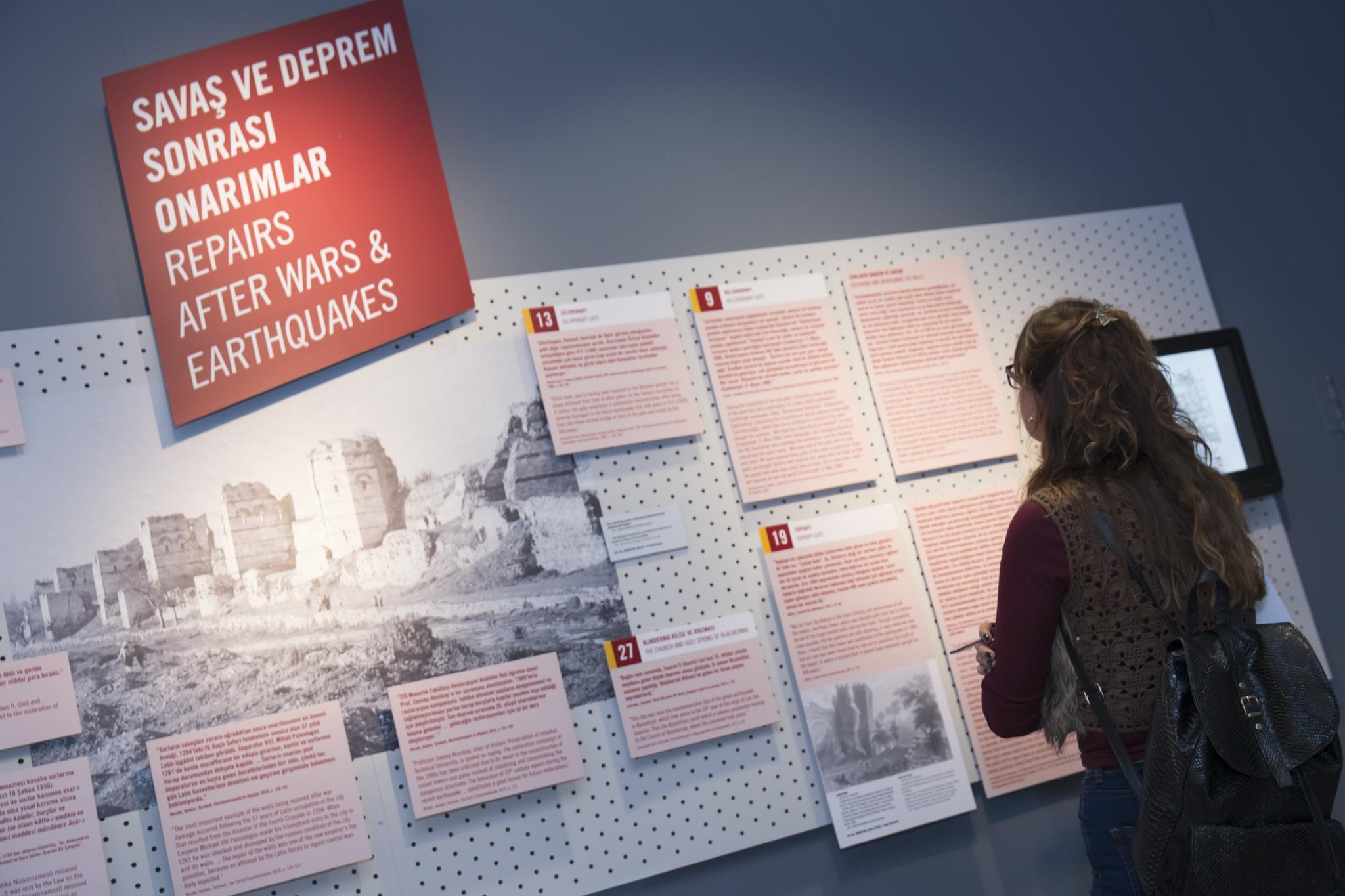Exhibit traces the cultural landscape around Istanbul’s land walls
Emrah Güler
 Surrounding the touristic hot spots of Hagia Sophia, Topkapı Palace, the Grand Bazaar and Basilica Cistern on Istanbul’s historical peninsula, you can find one of the least visited, under-rated attractions of the city, the walls of Istanbul. Built in fifth century by Byzantine Emperor Anthemius, and also called the Theodosian Walls today, the walls run from Yedikule on the Marmara Sea to Ayvansaray on the Golden Horn.
Surrounding the touristic hot spots of Hagia Sophia, Topkapı Palace, the Grand Bazaar and Basilica Cistern on Istanbul’s historical peninsula, you can find one of the least visited, under-rated attractions of the city, the walls of Istanbul. Built in fifth century by Byzantine Emperor Anthemius, and also called the Theodosian Walls today, the walls run from Yedikule on the Marmara Sea to Ayvansaray on the Golden Horn.A new exhibition by Koç University’s Research Center for Anatolian Civilization (ANAMED) puts the walls of Istanbul and the surrounding area under the spotlight. “On the Fringe, The Istanbul Land Walls” exhibition traces the different historical periods on the walls, a multi-layered cultural landscape throughout the 1,600-year-history of the city.
The relationship of the walls to the water system and green spaces in the city, the spiritual and religious stories associated with the walls, the stories of the people who had lived and are living around the walls, and the recollections of the residents and travelers who have visited the walls are some of the highlights of the exhibition focusing on one of UNESCO’s World Heritage Sites.
The Hürriyet Daily News talked to the curator of the exhibition, Figen Kıvılcım Çorakbaş, an associate professor at Anadolu University’s Architecture Department. The walls have generally been talked in the context of the war of 1453, the Ottoman conquest when Constantinople became Istanbul. Kıvılcım Çorakbaş hopes to take the walls out of that context through the exhibition.
“The war is an event. History is made up mainly of events,” said Kıvılcım Çorakbaş. “On the other hand, the walls are an urban element, generating the form of the city around them. They create situations in an urban context. We were after situations and everyday life rather than events. We looked for traces clarifying the significance of the walls in urban history and daily life.”

Continuous wear-down and conservation
The exhibition was structured “by trying to relate different mediums like the model, numerous texts, videos, and maps, in a legible way.” The impressive model or the small replica of the land walls, covering the exhibition area, of the land walls was designed in a way to reflect the breakdowns and numerous restorations throughout their history. While visiting the exhibition and peering at the model, you will soon realize that you are walking over the map of the walls.
What will the visitors find marked on the map and the model? “Visitors will find the names of various historic places – religious places like mosques and churches, historic open spaces, and names of gates – which are situated around the walls,” she said. “They are mainly the places which are referred in historic resources. The quotations from various authors, which can be found on the panels, are the narratives revealing the intangible qualities of a tangible site.”
The wear and tear, maintenance and conservation of the walls have been an issue as old as the walls themselves. The first law on the Theodosian Walls was in 413 A.D., according to Kıvılcım Çorakbaş. “In the scope of this law, it is stated that the owners of the agricultural areas on which the walls are built can continue to own and use the lands for agricultural purposes. On the other hand, they are responsible for the maintenance of the towers that are situated on their lands.”
The 1,600-year-old walls have been repaired and reconstructed continuously in Byzantine and Ottoman periods, witnessing their worst condition in the 19th century, following the end of the control of the Ottoman military force of the walls in 1836, according to Kıvılcım Çorakbaş. “Although the necessary laws were generated at the end of Ottoman period, practically the integrated conservation of the walls never took place.”
Cemeteries, walls and gardens
Kıvılcım Çorakbaş highlighted the rapid urbanization and heavy-traffic roads that were built around the walls in the Turkish republican period as factors that threatened the walls, while also noting the subsequent difficulties in restoration and reconstruction works. “Being on the fringe, the walls and the surrounding area hosted a variety of urban functions with huge open areas, as vegetable gardens, sports and industrial areas, urban parks,” said Kıvılcım Çorakbaş. “In time, not only these huge areas but also old neighborhoods suffered real estate development pressures.”
For Kıvılcım Çorakbaş, “not only the walls, but also the area surrounding them requires an integrated and participative conservation approach.” Among the historic components of the walls are the cemeteries and agricultural areas.
“The cemeteries and the walls constituted the characteristic silhouette of the city of Istanbul,” Kıvılcım Çorakbaş said, quoting early 20th-century novelist and essayist Ahmet Hamdi Tanpınar from his book “Five Cities.”

But Kıvılcım Çorakbaş adds vegetable gardens to Tanpınar’s list that had made Istanbul’s silhouette. “In the 19th century, the traveler and author Edmondo de Amicis was impressed by the integrity of the cemeteries, vegetable gardens and the walls, together with numerous monuments and neighborhoods of course,” she said. “The walls combine natural and cultural assets in the same context. In order to conserve the integrity and authenticity of the walls, we need to conserve their context with its natural and cultural assets.”
If you’d like to walk along the walls, Kıvılcım Çorakbaş has a few suggestions. “You can walk along the walls from Yedikule to Silivrikapı and then to the Balıklı Rum Orthodox Church and Holy Water.” As for other routes, she suggests that visitors check out the exhibition’s “Walking along the Walls” section.
For more information on “On the Fringe, The Istanbul Land Walls” exhibition, visit anamed.ku.edu.tr.
















